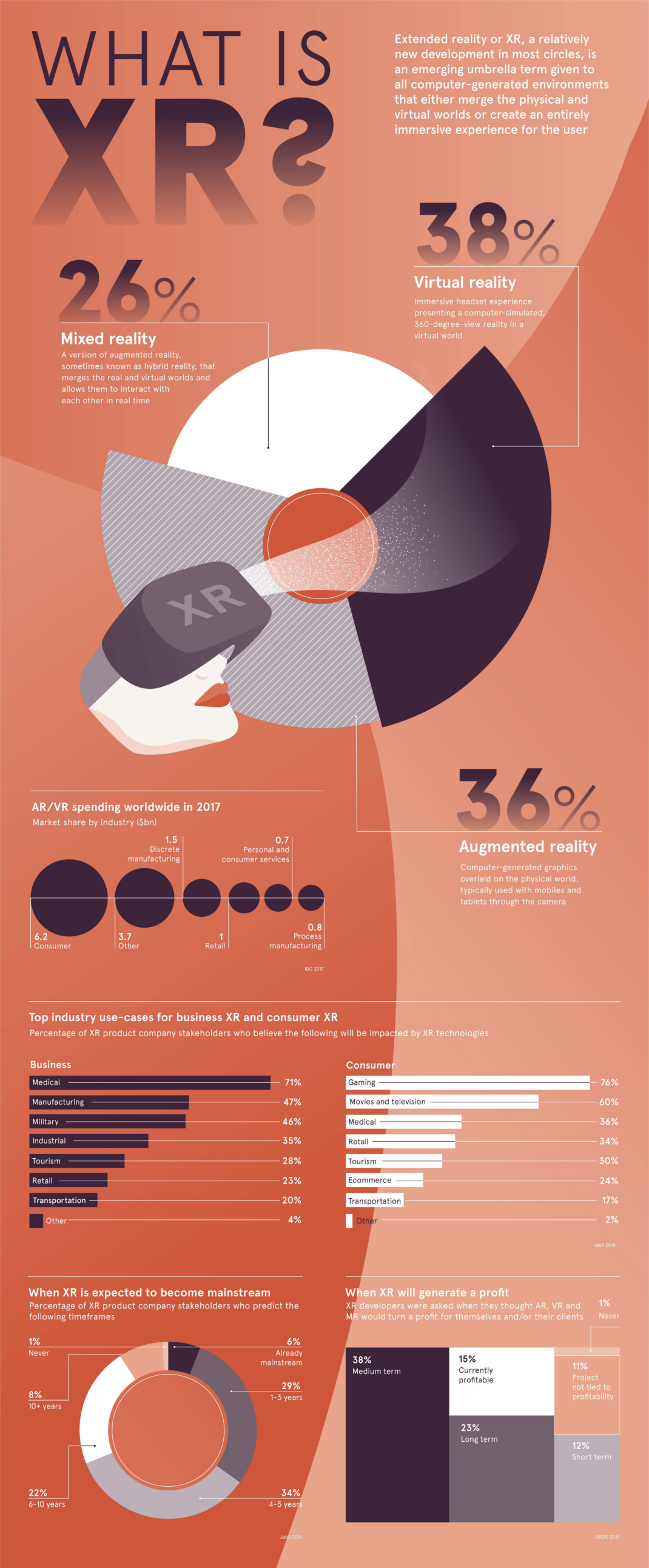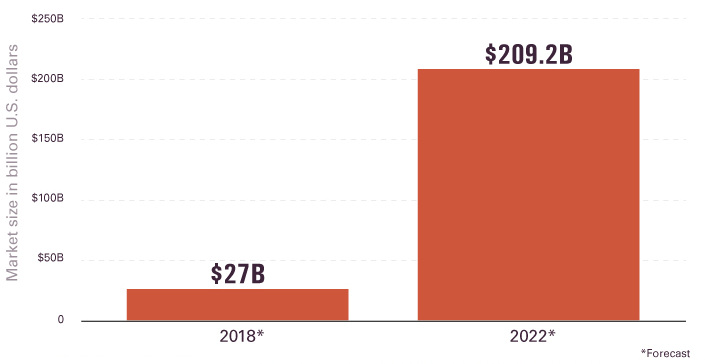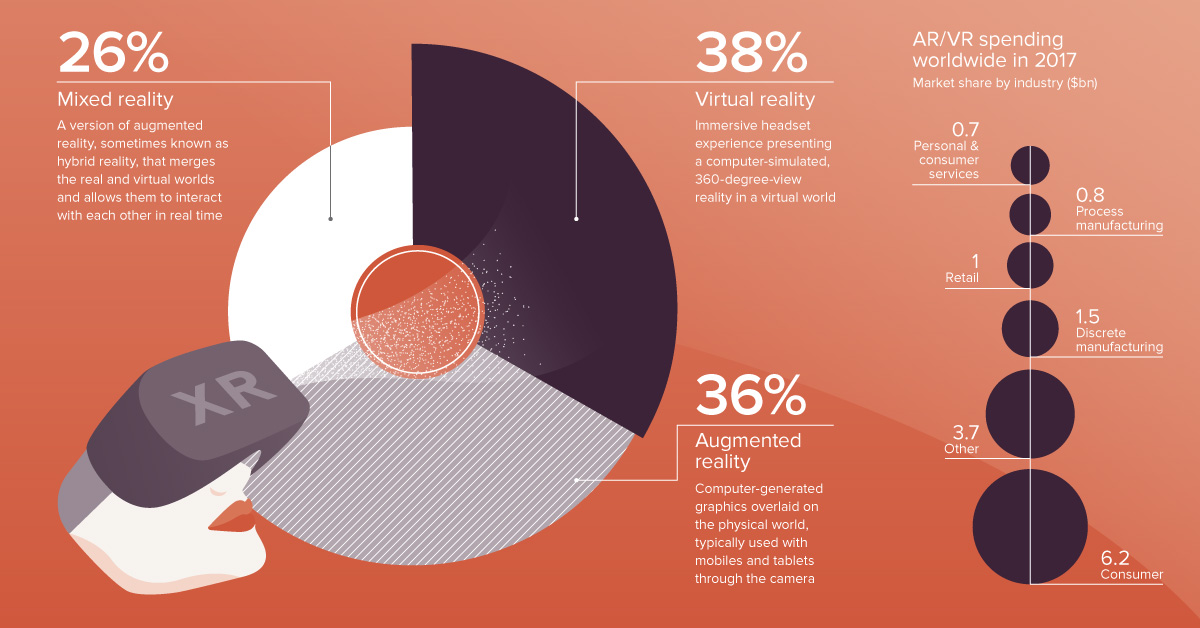Technology
What is Extended Reality (XR)?

What is Extended Reality (XR)?
It’s the year 2030, and you have a busy day scheduled. You need to check on your production lines in China, visit Mars during your lunch break, and attend a business meeting in Brazil – all from the comfort of your office in New York.
While it might sound far-fetched now, this future might be within our grasp thanks to advancements in Extended Reality (XR). Today’s infographic from Raconteur illustrates the growth of XR technology, and its potential to transform business across industries.
Understanding Extended Reality
To understand Extended Reality (XR), we’ll begin by defining three of its main components: virtual, augmented, and mixed reality.
Virtual Reality
Virtual Reality (VR) applications use headsets to fully immerse users in a computer-simulated reality. These headsets generate realistic sounds and images, engaging all five senses to create an interactive virtual world.
Augmented Reality
Augmented Reality (AR) is not a new reality, but a layer on top of your existing one. Rather than immersing users, AR relies on a device – usually the camera in your phone or tablet – to overlay digital graphics and sounds into a real-world environment. Pokémon Go and Snapchat filters are commonplace examples of this kind of technology.
Mixed Reality
Mixed Reality (MR) lies somewhere in between VR and AR. It blends real and virtual worlds to create complex environments where physical and digital elements can interact in real time. Like AR, it overlays synthetic content in a real-world environment; and like VR, this content is interactive, and users can manipulate the digital objects in their physical space.
With their Spectator View, Microsoft has used MR as a complement to their HoloLens AR product. The Spectator View app offers users a third-party perspective of a HoloLens user and their AR content in real time.
Extended Reality
Extended Reality (XR) is the umbrella term used for VR, AR, and MR, as well as all future realities such technology might bring. XR covers the full spectrum of real and virtual environments.
The use of an umbrella term speaks to the future of XR as a fundamental shift in the way people interact with media. In the future, instead of saying “I’m using AR to attend a business meeting” – it will just be another day at the office. People will interact with the real and virtual worlds in seamless ways, without mention of extended reality’s distinct categories and their underpinning technology.
To use an umbrella term is to recognize the intersection of these technologies, and the many ways they will work together to disrupt our everyday tasks.
XR for Business
Extended reality is changing the landscape in a number of industries. It’s expected to grow eightfold, reaching an estimated market size of more than $209 billion by 2022.

A glance at current use cases shows the potential for XR across industries:
- Entertainment
XR brings immersive experiences to the entertainment world, and offers consumers an opportunity to virtually experience live music and sporting events from the comfort of their VR headset. While a majority of market share leans heavily towards entertainment, it’s not the only one gearing up for a virtual expansion. - Marketing
Virtual realities have opened new ways for brands to engage with consumers, offering immersive ways to interact with new products. - Training
Extended reality opens new avenues for training and education. People who work in high-risk conditions – like chemists and pilots – can train in safety from a more conventional classroom setting. Medical students, meanwhile, can get hands-on practice on virtual patients. - Real Estate
Property managers can streamline the rental process by allowing potential tenants to view properties virtually, while architects and interior designers can leverage XR to bring their designs to life. - Remote Work
XR removes distance barriers, allowing remote employees to seamlessly access data from anywhere in the world.
Extended reality is not without its challenges. The spread of data presents a new layer of vulnerability for cyber attacks, while the high cost of implementation is a barrier to entry for many companies.
But even these challenges can’t slow the progress of XR, and the question remains: how will businesses define reality five years from now?
Technology
Visualizing AI Patents by Country
See which countries have been granted the most AI patents each year, from 2012 to 2022.

Visualizing AI Patents by Country
This was originally posted on our Voronoi app. Download the app for free on iOS or Android and discover incredible data-driven charts from a variety of trusted sources.
This infographic shows the number of AI-related patents granted each year from 2010 to 2022 (latest data available). These figures come from the Center for Security and Emerging Technology (CSET), accessed via Stanford University’s 2024 AI Index Report.
From this data, we can see that China first overtook the U.S. in 2013. Since then, the country has seen enormous growth in the number of AI patents granted each year.
| Year | China | EU and UK | U.S. | RoW | Global Total |
|---|---|---|---|---|---|
| 2010 | 307 | 137 | 984 | 571 | 1,999 |
| 2011 | 516 | 129 | 980 | 581 | 2,206 |
| 2012 | 926 | 112 | 950 | 660 | 2,648 |
| 2013 | 1,035 | 91 | 970 | 627 | 2,723 |
| 2014 | 1,278 | 97 | 1,078 | 667 | 3,120 |
| 2015 | 1,721 | 110 | 1,135 | 539 | 3,505 |
| 2016 | 1,621 | 128 | 1,298 | 714 | 3,761 |
| 2017 | 2,428 | 144 | 1,489 | 1,075 | 5,136 |
| 2018 | 4,741 | 155 | 1,674 | 1,574 | 8,144 |
| 2019 | 9,530 | 322 | 3,211 | 2,720 | 15,783 |
| 2020 | 13,071 | 406 | 5,441 | 4,455 | 23,373 |
| 2021 | 21,907 | 623 | 8,219 | 7,519 | 38,268 |
| 2022 | 35,315 | 1,173 | 12,077 | 13,699 | 62,264 |
In 2022, China was granted more patents than every other country combined.
While this suggests that the country is very active in researching the field of artificial intelligence, it doesn’t necessarily mean that China is the farthest in terms of capability.
Key Facts About AI Patents
According to CSET, AI patents relate to mathematical relationships and algorithms, which are considered abstract ideas under patent law. They can also have different meaning, depending on where they are filed.
In the U.S., AI patenting is concentrated amongst large companies including IBM, Microsoft, and Google. On the other hand, AI patenting in China is more distributed across government organizations, universities, and tech firms (e.g. Tencent).
In terms of focus area, China’s patents are typically related to computer vision, a field of AI that enables computers and systems to interpret visual data and inputs. Meanwhile America’s efforts are more evenly distributed across research fields.
Learn More About AI From Visual Capitalist
If you want to see more data visualizations on artificial intelligence, check out this graphic that shows which job departments will be impacted by AI the most.
-

 Markets1 week ago
Markets1 week agoU.S. Debt Interest Payments Reach $1 Trillion
-

 Markets2 weeks ago
Markets2 weeks agoRanked: The Most Valuable Housing Markets in America
-

 Money2 weeks ago
Money2 weeks agoWhich States Have the Highest Minimum Wage in America?
-

 AI2 weeks ago
AI2 weeks agoRanked: Semiconductor Companies by Industry Revenue Share
-

 Markets2 weeks ago
Markets2 weeks agoRanked: The World’s Top Flight Routes, by Revenue
-

 Countries2 weeks ago
Countries2 weeks agoPopulation Projections: The World’s 6 Largest Countries in 2075
-

 Markets2 weeks ago
Markets2 weeks agoThe Top 10 States by Real GDP Growth in 2023
-

 Money2 weeks ago
Money2 weeks agoThe Smallest Gender Wage Gaps in OECD Countries
















